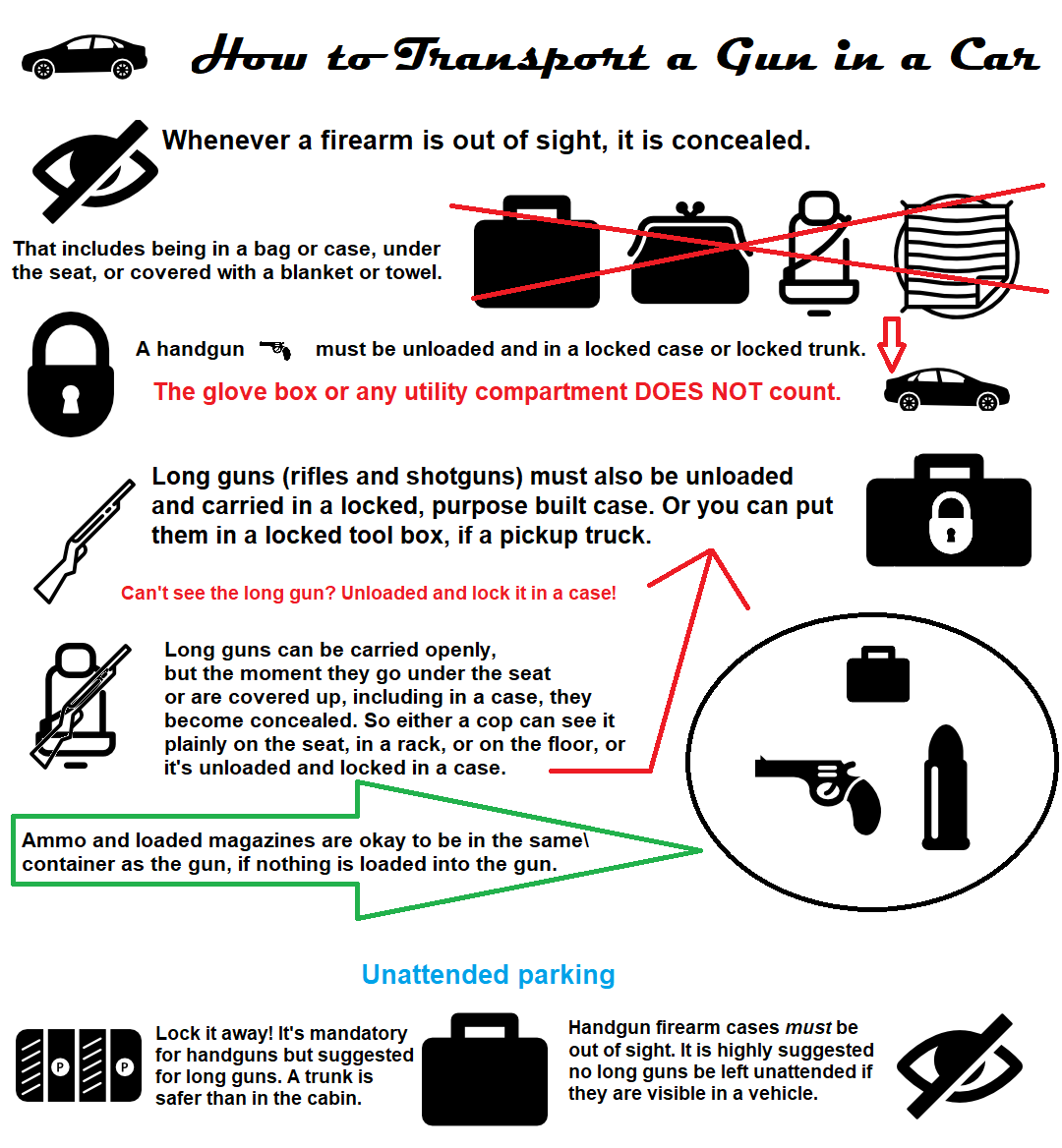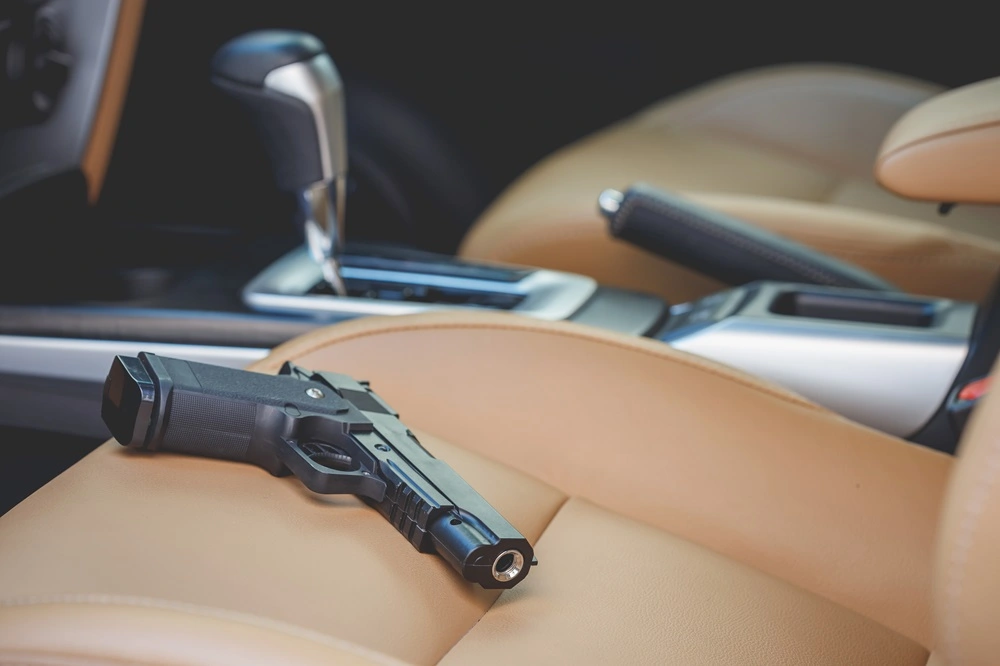You’re about to hit the road, and you’ve got important cargo: your firearm. Ensuring its safe and legal transport is crucial, not just for your peace of mind, but for the safety of everyone around you.
Have you ever felt unsure about the best way to carry a firearm in your vehicle? You’re not alone. Many responsible gun owners grapple with this concern. The answer isn’t just about following the law; it’s about ensuring safety and preventing any accidental mishaps.
We’ll reveal the safest methods to transport a firearm, providing you with the confidence and knowledge you need every time you travel with your gun. Keep reading to discover practical tips that make a real difference.

Legal Requirements
Transporting a firearm in a vehicle requires understanding legal guidelines. Ensuring safety and legality is crucial. Different laws apply at federal and state levels. Knowing these laws prevents legal issues and ensures safe transport.
Federal Laws
Federal laws set the groundwork for firearm transport. Firearms must be unloaded during transport. Store them in a locked compartment. The trunk is often ideal. Ammunition must be separate from the firearm. This reduces the risk of accidental discharge. Ensure compliance to avoid federal penalties.
State Regulations
State regulations vary widely. Some states have stricter rules than federal guidelines. Check local laws before traveling. States may require permits for transport. Others might mandate specific storage methods. Ignoring state laws can lead to fines or legal trouble. Stay informed to ensure safe and legal firearm transport.
Firearm Safety Basics
Transporting a firearm in your vehicle demands responsibility and understanding of safety basics. It’s not just about following the law; it’s about protecting yourself and others from accidental harm. Imagine the peace of mind knowing your firearm is secured properly. To achieve that, let’s dive into some essential safety practices.
Handling Precautions
Always treat a firearm as if it’s loaded. This mindset should be your default setting every time you handle a gun. It’s not just a rule; it’s a lifesaver. Make sure the safety mechanism is engaged before you transport your firearm. You wouldn’t want any accidental discharge, right?
Before placing your firearm in the vehicle, double-check that it’s unloaded. A simple check can prevent serious mishaps. Always point the muzzle in a safe direction. Think of it as controlling where the energy goes.
Storing Guidelines
Your firearm should be stored in a case or container. This keeps it secure and prevents it from moving around in your vehicle. Use lockable cases to add an extra layer of security. It’s about protecting your firearm from theft or misuse.
Avoid storing it in places where it can be easily accessed by unauthorized individuals. The trunk is usually a safe spot. But, what if you’re driving a truck? Consider a lockbox or a compartment designed for firearms.
Separate the ammunition from the firearm. This is crucial, as it minimizes risks associated with accidental discharge. Think about your loved ones who might be in the vehicle with you.
Are you confident in your firearm safety practices? Knowing these basics not only aligns with legal requirements but also ensures your peace of mind. With these precautions, you’ll be safeguarding lives, including your own. Can you afford to overlook such important safety measures?
Choosing The Right Case
Selecting a secure case ensures safe firearm transport in vehicles. Hard cases with sturdy locks prevent accidental access. Padding inside offers added protection against jostling and impacts.
Transporting a firearm safely in a vehicle requires careful planning, and choosing the right case is a crucial step. The case you select should provide adequate protection and meet legal requirements, ensuring both safety and compliance. Whether you’re a seasoned hunter or new to firearm ownership, understanding the different case options can make your journey smoother and worry-free.Hard Cases
Hard cases offer robust protection for your firearm, shielding it from bumps and external damage. They are typically made from durable materials like plastic or aluminum, providing a solid barrier against impacts. Consider the hard case as an investment in safety. I once transported my rifle in a hard case across rough terrain, and despite the bumpy ride, my firearm remained secure and unscathed. These cases can be bulkier, so think about your vehicle’s storage space. Will it fit easily in your trunk or backseat? Evaluating the size and space can save you from unnecessary hassles later.Soft Cases
Soft cases are more flexible and lightweight, making them easier to handle and store. They are often crafted from materials like nylon or canvas, offering a degree of protection while being more portable. Picture this: you’re heading to the shooting range, and a soft case allows you to carry your firearm with ease. It’s less cumbersome, fitting snugly in your car and freeing up space for other gear. However, they provide less impact resistance compared to hard cases. If you choose a soft case, ensure it has adequate padding to protect your firearm from minor dings and scratches.Lockable Options
Lockable cases provide an added layer of security, crucial for preventing unauthorized access. A lockable case gives peace of mind, especially if you need to leave your firearm in the car briefly. Think about this: you’ve stopped for a quick bite during your road trip, and knowing your firearm is locked securely in its case can ease your worries. It’s about taking that extra step for safety. When selecting a lockable case, check the locking mechanism. Is it easy to use? Reliable locks can deter potential theft, ensuring your firearm remains where it should be—safely contained within your vehicle. Choosing the right case for your firearm is not just about preference; it’s about safety, security, and peace of mind. Have you found the case that suits your needs?
Transporting In Vehicles
Transporting a firearm in a vehicle requires careful consideration and adherence to legal guidelines. Safety must be the top priority. Ensuring the firearm is transported correctly is crucial for everyone’s safety. Understanding the best practices can prevent accidents and legal issues.
Placement In The Vehicle
Place the firearm in a secure location within the vehicle. Avoid areas that are easily accessible. The trunk is often the best option. If your vehicle lacks a trunk, use a lockable case. The backseat is another potential spot, but ensure it is not within reach while driving. Always keep the firearm unloaded during transport. Check state laws for specific placement rules.
Securing The Firearm
Securing the firearm is vital to prevent movement. Use a quality lock to secure the firearm in its case. Cable locks or trigger locks provide added security. Ensure the case is sturdy and cannot be easily opened. Consider investing in a gun safe designed for vehicles. This adds an extra layer of protection. Always keep ammunition separate from the firearm during transport. This practice enhances safety significantly.
Air Travel Considerations
Transporting a firearm safely in a vehicle involves securing it in a locked container. Keep it unloaded and separate from ammunition. Ensure it is inaccessible during transit to comply with legal regulations.
Transporting a firearm during air travel can be daunting, given the stringent regulations and potential pitfalls. Understanding the nuances of airline policies and TSA guidelines is crucial to ensuring a safe and hassle-free journey. Whether you’re a seasoned traveler or a first-timer, these insights will help you navigate the complexities of flying with a firearm.Airline Policies
Each airline has its own set of rules for transporting firearms. Always check with your airline ahead of time to avoid surprises at the airport. Some airlines might require you to notify them in advance, while others may have specific packaging requirements. For example, airlines often mandate that firearms be unloaded and stored in a hard-sided, locked container. It’s your responsibility to ensure the container is secure and meets airline standards. Don’t forget to declare your firearm at check-in; failing to do so could lead to delays or penalties.Tsa Guidelines
The Transportation Security Administration (TSA) has clear-cut guidelines for flying with firearms. Familiarizing yourself with these regulations can save you from unnecessary headaches. First and foremost, firearms must be unloaded and stored in a locked, hard-sided case. Ammunition should be packed separately, following the TSA’s specific rules about quantity and packaging. You might be surprised to learn that carrying ammunition in magazines is often acceptable, provided they are securely boxed. When you arrive at the airport, declare your firearm to the airline representative at check-in. You’ll likely need to fill out a declaration form and accompany your luggage to the TSA screening area. This process ensures that your firearm is safely stowed in the cargo hold, away from passengers. Have you ever considered how a small oversight, like failing to lock your firearm case, could disrupt your travel plans? Double-check every detail to ensure compliance with both airline and TSA rules. This diligence not only keeps you on the right side of the law but also enhances your peace of mind during your travels.Public Transport Guidelines
Transporting firearms safely on public transport requires careful attention to rules and guidelines. Public transport systems have specific regulations to ensure passenger safety. Understanding these rules is crucial for a responsible firearm owner. Let’s explore what you need to know.
Train And Bus Rules
Train operators often have strict rules about firearms. Always check with the specific train company. Firearms should be unloaded. Secure them in a locked container. Ammunition should be stored separately. This ensures safety for all passengers. Bus companies may have similar guidelines. Verify the rules before boarding. Keep firearms concealed in a proper case. Avoid alarming other passengers.
Urban Commute Tips
Urban commuting poses unique challenges for firearm transport. Choose a discreet, sturdy case. Avoid drawing attention to your firearm. If possible, travel during non-peak hours. Crowded spaces can increase the risk of accidents. Stay aware of local laws and regulations. City ordinances might differ from state laws. Always stay informed and compliant.
International Transport
Transporting firearms internationally requires careful planning and adherence to regulations. Each country has its own rules for firearm transport. Understanding these is crucial to avoid legal complications. Begin with researching the destination country’s laws. This ensures compliance with all necessary regulations.
Customs Procedures
Customs procedures can vary significantly between countries. Familiarize yourself with the specific requirements of the destination. Many countries require firearms to be declared at customs. This means filling out specific forms upon arrival. Some countries may also require advance permission to transport firearms. Checking these requirements early is essential.
Documentation Needed
Proper documentation is vital for international firearm transport. You will need a firearm ownership license. A permit for transporting firearms is often necessary. Include any export or import permits required by the countries involved. Keep all documents easily accessible during travel. This ensures a smooth process at customs checkpoints.
Emergency Protocols
Transporting a firearm safely in a vehicle involves securing it in a locked case. The firearm should be unloaded, with ammunition stored separately. Keeping the case in a location not easily accessible from the driver’s seat enhances safety and complies with legal regulations.
When transporting a firearm in a vehicle, understanding emergency protocols can make a significant difference in ensuring your safety and compliance with the law. Emergencies can arise unexpectedly, leaving you little time to think. Having a plan in place is crucial for handling these situations effectively.Responding To Incidents
Imagine you’re driving and suddenly get into a minor accident. Your first instinct might be to check for injuries and damages, but what about the firearm in your vehicle? Secure it immediately. Make sure it remains out of public view and is still unloaded. This small step can prevent unnecessary panic and misunderstandings. Ask yourself, have you practiced how you would handle such an incident? Knowing your course of action beforehand reduces stress and helps you think clearly when it counts the most. Keep a checklist in your vehicle’s glove compartment as a handy reminder of your emergency steps.Reporting Requirements
Understanding the legal requirements for reporting firearm-related incidents is crucial. Laws vary by state, but generally, you must report any incident involving a firearm to the local authorities. This includes theft, accidental discharge, or if the firearm is lost during an accident. Make it a priority to familiarize yourself with the specific reporting rules in your area. This knowledge can protect you from potential legal trouble. Have the contact information for local law enforcement readily available in your phone or vehicle. What would you do if your firearm was stolen from your vehicle? The faster you report it, the better the chances of recovery and avoiding liability for any misuse. Being prepared not only ensures compliance but also helps maintain peace of mind in challenging situations.
Frequently Asked Questions
How Should Firearms Be Stored In A Vehicle?
Firearms should be stored unloaded in a locked container. The container should be separate from the ammunition. This reduces the risk of accidents and unauthorized access. Always follow local laws and regulations regarding firearm transportation. Using a trigger lock adds an extra layer of safety.
Can I Transport A Loaded Firearm In My Car?
Transporting a loaded firearm in a vehicle is generally not recommended. It increases the risk of accidental discharge. Always unload firearms before transportation. Keep the firearm and ammunition in separate, secure locations. Familiarize yourself with your state’s specific laws regarding loaded firearms in vehicles.
Is A Gun Case Necessary For Vehicle Transport?
A gun case is highly recommended for transporting firearms in a vehicle. It offers protection against damage and unauthorized access. A hard-sided, lockable case provides the best security. Ensure the firearm is unloaded before placing it in the case. This practice helps ensure safer transport.
Where Should Ammunition Be Stored During Transport?
Store ammunition separately from the firearm during transport. Use a secure, locked container for ammunition storage. This minimizes the risk of accidents and unauthorized access. Keeping them apart complies with many state laws. Always check and follow local regulations regarding ammunition transport.
Conclusion
Transporting firearms safely in vehicles requires careful planning. Choose a secure case. Lock it properly. Always separate ammunition. Ensure firearms are unloaded. Store them in the trunk. This prevents access during travel. Follow local laws and guidelines. Each state may have different rules.
Understand the laws where you travel. Safety is the top priority. Protect yourself and others. Avoid unnecessary risks. Being responsible ensures peace of mind. Safe transport keeps everyone safe. Make safety a habit every time. Always remember, responsible transport is smart.



